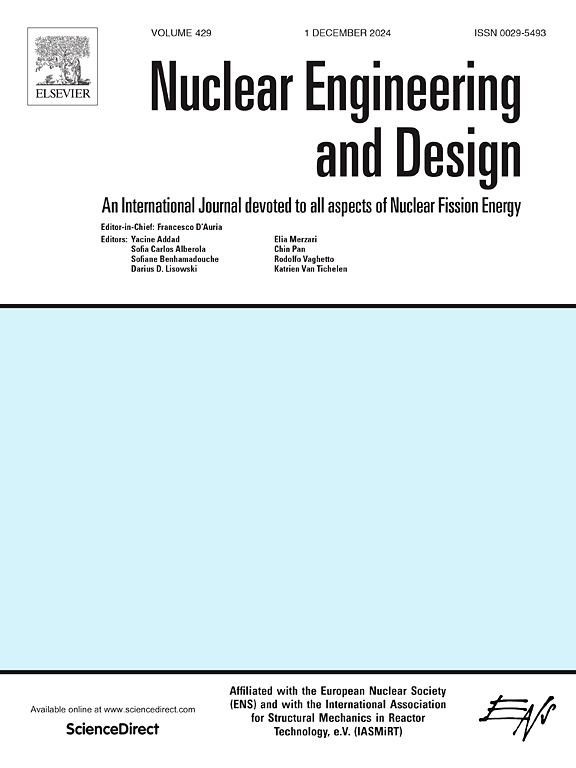静止和轧制条件下c型换热器热分层特性的实验研究
IF 1.9
3区 工程技术
Q1 NUCLEAR SCIENCE & TECHNOLOGY
引用次数: 0
摘要
本文研究了与海上浮动核电站(OFNPs)相关的二次被动余热去除系统(PRHRS)中c型换热器在静止和滚动工况下的热分层特性和运行性能。设计了一个按比例缩小的实验设施来模拟PRHRS,其中包括一个摇摆平台来复制海洋滚动运动。在不同的滚动幅度(15°、24°)和周期(8 s、14 s),加热功率分别为34 kW和31 kW的情况下进行实验,分析动态条件对系统排热能力、稳定性和热分层的影响。主要研究结果表明,滚动运动通过促进流体混合和自然循环,在初始运行阶段增强了热量的排出。然而,在准稳态下,轧制条件引起系统压力、质量流量和排热功率的周期性振荡,并与施加的轧制周期同步。在滚动运动下,由于流体混合增强,热分层减弱,但分层持续的时间增加。值得注意的是,较大的滚动振幅降低了换热器出口温度,而较长的滚动周期降低了系统压力。这些结果为优化在动态海洋环境中运行的OFNPs的PRHRS设计提供了重要见解。本文章由计算机程序翻译,如有差异,请以英文原文为准。
Experimental study on thermal stratification characteristics of C-shaped heat exchanger under stationary and rolling conditions
This study investigates the thermal stratification characteristics and operating performance of a C-shaped heat exchanger in the secondary passive residual heat removal system (PRHRS) under stationary and rolling conditions, relevant to Offshore Floating Nuclear Power Plants (OFNPs). A scaled-down experimental facility was designed to simulate the PRHRS, incorporating a swaying platform to replicate marine rolling motions. Experiments were conducted under varying rolling amplitudes (15°, 24°) and periods (8 s, 14 s), with heating powers of 34 kW and 31 kW, to analyze the effects of dynamic conditions on heat removal capacity, system stability, and thermal stratification. Key findings reveal that rolling motion enhances heat removal during the initial operational phase by promoting fluid mixing and natural circulation. However, under quasi-steady states, rolling conditions induced periodic oscillations in system pressure, mass flow rate, and heat removal power, synchronized with the imposed rolling period. Thermal stratification was weakened under rolling motion due to enhanced fluid mixing, though the duration of stratification persistence increased. Notably, larger rolling amplitudes reduced the heat exchanger outlet temperature, while longer periods lowered system pressure. These results provide critical insights into optimizing PRHRS design for OFNPs operating in dynamic marine environments.
求助全文
通过发布文献求助,成功后即可免费获取论文全文。
去求助
来源期刊

Nuclear Engineering and Design
工程技术-核科学技术
CiteScore
3.40
自引率
11.80%
发文量
377
审稿时长
5 months
期刊介绍:
Nuclear Engineering and Design covers the wide range of disciplines involved in the engineering, design, safety and construction of nuclear fission reactors. The Editors welcome papers both on applied and innovative aspects and developments in nuclear science and technology.
Fundamentals of Reactor Design include:
• Thermal-Hydraulics and Core Physics
• Safety Analysis, Risk Assessment (PSA)
• Structural and Mechanical Engineering
• Materials Science
• Fuel Behavior and Design
• Structural Plant Design
• Engineering of Reactor Components
• Experiments
Aspects beyond fundamentals of Reactor Design covered:
• Accident Mitigation Measures
• Reactor Control Systems
• Licensing Issues
• Safeguard Engineering
• Economy of Plants
• Reprocessing / Waste Disposal
• Applications of Nuclear Energy
• Maintenance
• Decommissioning
Papers on new reactor ideas and developments (Generation IV reactors) such as inherently safe modular HTRs, High Performance LWRs/HWRs and LMFBs/GFR will be considered; Actinide Burners, Accelerator Driven Systems, Energy Amplifiers and other special designs of power and research reactors and their applications are also encouraged.
 求助内容:
求助内容: 应助结果提醒方式:
应助结果提醒方式:


